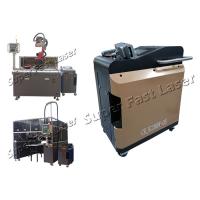CE Certified O ring Mold Laser Cleaning Machine Rubber Tyre Mold
Laser Cleaner Machine Rust Removal 100W
Technical parameters
| Item | L/N | Characteristics | Test Conditions | Min. | Typical | Max. | Unit |
| Electrical Characteristics | 1 | Power Voltage | 220 | 210 | 220 | 230 | AC |
| 2 | Maximum current loss | Pout=Pnom | 4 | 5 | 6 | A |
| 3 | Total Power | 600 | 590 | 600 | 610 | W |
| 4 | Fiber Cable | 5 | 5 | 5 | 10 | M |
| General Characteristics | 1 | Working temperature range | 0 | / | 60 | ℃ |
| 2 | Storage temperature | -10 | / | 60 | ℃ |
| 3 | Laser power | 100 | W |
| 4 | Peak power | >10KW | KW |
| 5 | Cooling method | Air Cooling | |
| 6 | Laser level | 4 Class | |
| 7 | Pulse energy | 1.5mJ | mJ |
| 8 | Laser wavelength | 1064 | nm |
| 9 | Preheat time | Reach to start operation | 0 | s |
| Achieve complete stability | 10 |
| 10 | Humidity | 10 | / | 95 | % |
| 11 | Laser machine size | L647*W440*H859 | mm |
| 12 | Weight | 70 | kg |
Product Description
Laser cleaning is one of the more modern versions of the cleaning
process and has rapidly replaced more traditional methods such as
dry-ice blasting or media blasting due to the numerous benefits
that it provides.
It offers these benefits as it works in a significantly different
way to the processes that have preceded it. Furthermore, using a
fiber laser as the medium also works in a much different way to
other types of cleaning methods. We have explored this in more
detail below and explained why laser-based cleaning is the most
efficient, safe and cost-effective cleaning solution on the market.
How does laser cleaning work?
The aim of this process is simple; to clean the surface of a
material (e.g. metal) that it is working with.
This is done for a number of reasons, such as to remove paint,
mould, or to prepare surfaces for treatment. Surfaces can easily
gather or contain contaminants such as carbon, rust, and rubber,
and laser cleaning offers an efficient and environmentally-friendly
way of removing these.
So how does the process actually work? A laser beam is pulsed at
the surface of a material, irradiating and vaporising the layer
until the desired depth of ablation has been reached. The pulse’s
output power and wavelength can be controlled, offering the user a
great deal of control when it comes to vaporising a material’s
surface with a high degree of accuracy.
How does the vaporisation work? The contaminants that are on the
surface layer of the material, such as the rubber or paint, absorb
the beam as it is directed at it. The heat of this beam quickly
irradiates this material.
Machine applications
1. Metal surface cleaning in narrow space, no died-end;
2. Mold cleaning, such as tire mold, electronic mold, food mold,
injection mode and etc.;
3. Grease, resin, gum, dust, stains, and produce residue removal;
4. Pre-treatment of welding, bonding, remove paint, rust, grease,
weld oxide or residue;
5. Quick rust and various oxides cleaning;
6. Metal surface coating removal, rapid painting removal;
7. Cultural relics cleaning, rock cleaning, exterior cleaning of
buildings.
8. Roughening of metal surface;
9. Treatment for precision parts;
10. Aerospace weapons, ship manufacture or maintenance and etc;
11. Nuclear power unit maintenance;
How does the process work?
While there are many different types of laser, they generally work
in the same way when it comes to cleaning, although output power,
pulse parameters, and wavelength can change dramatically.
The laser cleaning process works by having a laser pulse directed
at the surface of a material, which blasts this layer off. The
contaminants that you are trying to remove are mostly vaporised,
leaving very little waste material behind. Any waste that is left
is in the form of particle dust, and it’s a simple process to
suction this away.
By adjusting the laser output energy, you can remove virtually
anything from a surface including non-organic materials. By
controlling the energy levels, various surface contaminants cam be
removed (e.g. organics, mineral oxides or ceramics) with no damage
to the underlying substrate.
It is also a non-contact, and non-abrasive process
work be employed More (Definitions, Synonyms, Translation)









